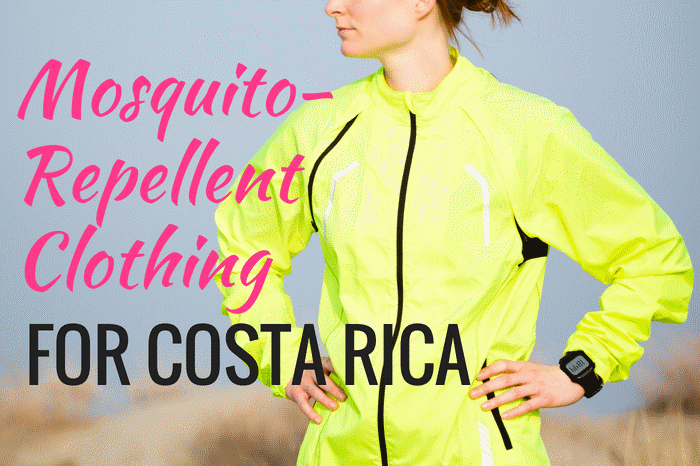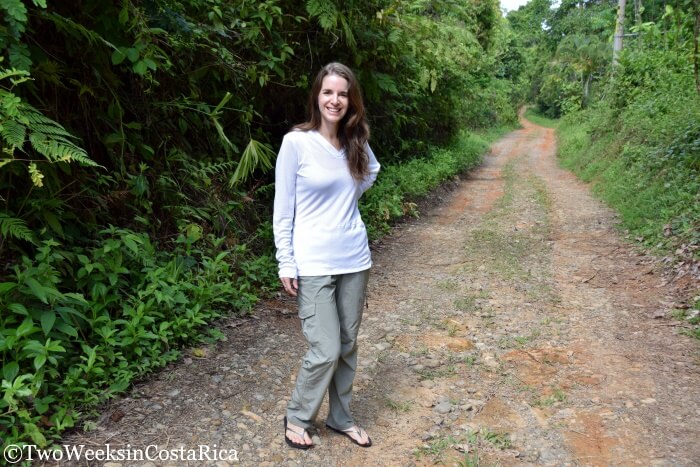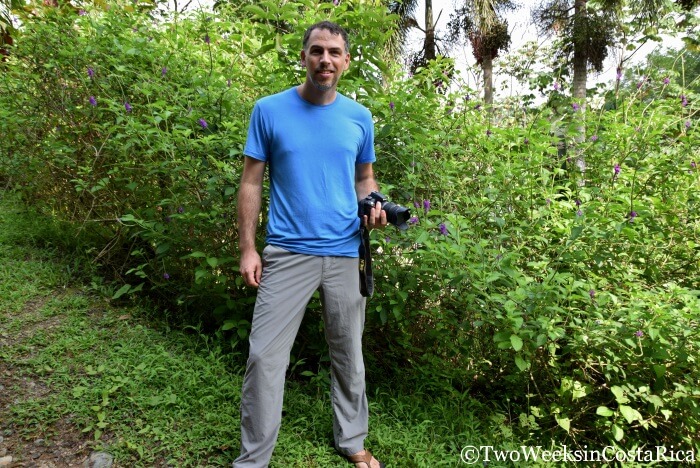Post Updated: May 21, 2019
Along with Costa Rica’s gorgeous tropical environment comes some unfortunate pests. Mosquitoes and other biting insects are found throughout the country and are particularly bothersome during the rainy season (May through November). Repellents work well to deter, but sometimes it’s nice not to have to lather up in strong-smelling lotions or sprays. After living in Costa Rica for six years, we have learned a lot about what works to avoid mosquito bites. Recently, we have been trying out specific clothing and seeing what a product called permethrin can do. In this post, we share some information on options for mosquito-repellent clothing in Costa Rica.

Mosquitoes in Costa Rica
Like most countries in Central and South America, Costa Rica has various mosquito-borne illnesses. Dengue is the most common. Chikungunya and Zika are less prevalent but still something to be aware of. For more information about these diseases, read our post Costa Rica and Mosquitoes: Tips to Prevent Zika, Dengue, and More.
Mosquito-Repellent Clothing
Repellents like DEET and picardin are effective against mosquito bites. (See our Mosquitoes post for our recommendations for repellents). But covering your skin is a great, simple way to prevent bites too. The type of clothing really matters, though, since mosquitoes can bite through many fabrics. Here are some guidelines:
- Choose tightly woven fabrics that mosquitoes have a hard time biting through, like nylon or polyester. These tend to be hotter so look for venting options, like sleeves that roll up, shirts that unbutton, etc. Avoid cotton and knit fabrics that bugs can easily penetrate.
- Wear long pants, long-sleeve shirts, and closed shoes with socks.
- Wear light colored clothing. Dark or bright fabrics attract biting insects.
- Loose fabrics are better. Mosquitoes can bite right through tight-fitting things like yoga pants.
Following these guidelines as described is not always practical, of course, since temperatures often get into the 80s or higher in Costa Rica. If it is very hot out, use your best judgment. The type of mosquito that transmits many of the viruses, the Aedes, bites feet and legs most often, so closed shoes and pants will go a long way towards protecting yourself. When hiking, we often wear pants and boots and a sleeveless shirt or T-shirt with repellent on top. In the rainy season, when the mosquitoes are the worst, temperatures do cool down considerably so that you can often wear a long sleeve top and pants.
Permethrin
Covering up in itself will save a lot of bites, but for the next level of protection, there’s permethrin. The CDC recommends clothing treated with permethrin as an effective repellent against mosquito bites, even for pregnant women.
Background
Permethrin is actually an insecticide. It’s a broad spectrum, non-systemic, synthetic pyrethroid insecticide that targets adults and larvae of many species of biting insects, including mosquitoes. It has been registered with the EPA since 1979 and is used in a variety of settings. Interestingly, the US military first started using it as a repellent on clothing in 1990. Around that time, the EPA also approved it as a spray for use on clothing and gear by consumers. Then in 2003, the EPA approved the first consumer-oriented, permethrin factory-treated clothing products like you can buy today.
Permethrin works in a unique way. Unlike DEET and picardin, which prevent mosquitoes from landing on you in the first place, permethrin works by killing or incapacitating mosquitoes once they land. So they do land on you, but are then killed by the chemical when they touch your clothing.
Safety
When used as directed, permethrin is supposed to be safe. The EPA’s exposure and risk assessment analysis found that permethrin factory-treated clothing is unlikely to pose any significant immediate or long-term health hazard. The key is that the amount of permethrin allowed in clothing is very low, and also that permethrin is poorly absorbed through the skin. So when you wear clothing that has been treated with it, very little actually gets into your body.
Effectiveness
The CDC recommends permethrin as an effective way to prevent mosquito bites. We have found from wearing our permethrin-treated clothing that we receive fewer bites. Of course, you have to be careful to apply repellent on any remaining exposed parts of your body. And you also have to be mindful that the protection won’t last forever. For clothing that is factory treated with permethrin, most manufacturers give a guarantee of 70 washes. After that, it would need to be treated again.
Mosquito-Repellent Clothing Options – What to Buy
We like to have a mix of clothing, some that has been treated with permethrin for very buggy areas and others that have not treated. You can buy permethrin specifically designed to be sprayed on clothing and apply it to items you already have. You just have to apply it evenly and follow the package instructions. For us, factory treated seemed to be the better option for longevity and it also avoided having to do the treatment ourselves.
Women
For bottoms, Jenn loves the fit of these hiking pants from Unitop. They’re very lightweight and flattering. Fabric is mostly nylon (88%) with a little bit of spandex, which helps them stretch when you move. If you prefer a different cut, any kind of nylon hiking pants will work. For something with permethrin, the Bugsaway Damselfly pant is a good pick.
For tops, Jenn loves her Bugsaway Lumen Hoody from ExOfficio. This is a long-sleeve shirt made of polyester (70%) and cotton (30%). The fabric is a mesh weave so very breathable and perfect for Costa Rica. This shirt is treated with permethrin.

The Sol Cool Ultimate Hoody is another one of her favorites. This is made of polyester with a little bit of spandex for stretch. It provides excellent coverage, with a roomy hood that goes way over the head for particularly buggy areas. The fabric is embedded with xylitol, which is supposed to keep you cool when you sweat. It also has ventilation along the underarms and sides. [Here is a link to a similar shirt with more sizing options.]
Jenn also gets a lot of use out of her classic Columbia button-up shirts (made of nylon). You can wear these on the trail and they also look great on a boat. The sleeves roll up into short sleeves.
Men
For men, Matt loves his ExOfficio Sol Cool Nomad Pants. They’re super lightweight despite being 100% nylon, fit really well, and look good enough to wear anywhere, not just for outdoor activities. He especially likes to wear them when we go to restaurants at night, to prevent bugs from getting his legs. If you prefer pants treated with permethrin, check out the Sandfly pant from ExOfficio.
For shirts, this simple long-sleeve jersey crew neck is good for hot weather and keeps the bugs away with Insect Shield (permethrin). Matt also likes to throw on his super lightweight Marmot raincoat when it’s cooler out and the bugs are biting. It has armpit zippers to keep him cooler in warmer weather.

Conclusion
There is no 100% effective solution against mosquito bites, but wearing the right clothing can help a lot. We hope that this article gave you some ideas for the best mosquito-protection clothing in Costa Rica.
Post Updated: May 21, 2019
Have a question about what to wear for mosquito protection in Costa Rica? Ask us below.
Some of the links in this post are connected to affiliate programs we have joined. As an Amazon Associate we earn from qualifying purchases.
Looking for more information to plan your trip? Check out these posts:
Packing List: For a general list of what other clothing you should bring as well as essential gear, check out our packing list.
Money Matters: Wondering what to budget for your trip? Read our Money post for information on how much things costs, currency exchange, and tipping.
Simple Spanish for Visiting Costa Rica: Study this handy list to know basic greetings, how to order in a restaurant, take a taxi, and more.

